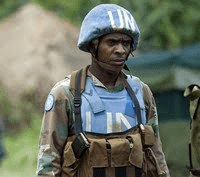In eastern Democratic Republic of Congo, the annual arrival of the holiday season brings with it the sinking realization that no matter the developments of the preceding 12 months, the end of the year will be accompanied by more violence, more sexual assault and more displacement of the civilian populations living in the shadow of the darkly beautiful volcanoes in the Kivu provinces.
This year's tragedy is tinged peacekeeper blue. The world's largest and most expensive U.N. peacekeeping mission, MONUC, has now conducted nine months of joint operations with the Congolese army, the FARDC. But that dismal and undisciplined force is excoriated by a cross-section of rights advocates and humanitarian actors as actually corroding rather than improving the situation in the east.
Ostensibly, Operation Kimia II was the second phase in a wider effort to rid the east of the last remnants of the Hutu militias responsible for the genocide in Rwanda in 1994 -- some 4,000 officers of the Forces Démocratique pour la Libération de Rwanda (FDLR). Their presence and the perceived, if implicit, support they received from the Congolese government contributed to the hostility between Kinshasa and the Tutsi-led government in Rwanda, which warned that it reserved the right cross the border for a third time in a decade to eliminate the FDLR itself.

